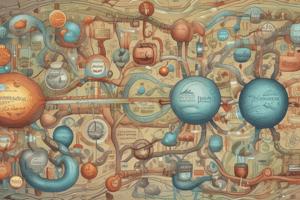Podcast
Questions and Answers
What defines a metabolic pathway?
What defines a metabolic pathway?
- The totality of all chemical reactions occurring within an organism.
- Any process that converts energy from one form to another.
- A series of catabolic reactions that occur in cellular respiration.
- A sequence that starts with a specific molecule and ends with a product. (correct)
Which enzyme primarily catalyzes the breakdown of substrates through hydrolysis?
Which enzyme primarily catalyzes the breakdown of substrates through hydrolysis?
- Hydrolases (correct)
- Transferases
- Ligases
- Isomerases
How does feedback inhibition regulate enzyme activity?
How does feedback inhibition regulate enzyme activity?
- Through competitive inhibition of the active site.
- By increasing the temperature of the metabolic pathway.
- By altering the shape of an enzyme through an allosteric site binding. (correct)
- By promoting the synthesis of the enzyme's product.
Which statement best characterizes catabolic pathways?
Which statement best characterizes catabolic pathways?
Which form of energy is associated with the random movement of atoms and molecules?
Which form of energy is associated with the random movement of atoms and molecules?
What is the role of biochemicals in bioenergetics?
What is the role of biochemicals in bioenergetics?
Which process is an example of an anabolic pathway?
Which process is an example of an anabolic pathway?
What happens to enzyme activity when a concentration of an inhibiting molecule is high?
What happens to enzyme activity when a concentration of an inhibiting molecule is high?
What is the primary function of ATP in cellular metabolism?
What is the primary function of ATP in cellular metabolism?
Which statement best summarizes the first law of thermodynamics?
Which statement best summarizes the first law of thermodynamics?
What is an exergonic reaction?
What is an exergonic reaction?
What effect does every energy transfer have according to the second law of thermodynamics?
What effect does every energy transfer have according to the second law of thermodynamics?
Which molecule is formed when ADP gains a phosphate group?
Which molecule is formed when ADP gains a phosphate group?
What is the role of enzymes like dehydrogenase in cellular reactions?
What is the role of enzymes like dehydrogenase in cellular reactions?
In redox reactions, what occurs during oxidation?
In redox reactions, what occurs during oxidation?
What characterizes a spontaneous process in the context of energy transfer?
What characterizes a spontaneous process in the context of energy transfer?
Which best describes the nature of living organisms regarding thermodynamics?
Which best describes the nature of living organisms regarding thermodynamics?
What is a phosphorylated intermediate?
What is a phosphorylated intermediate?
Flashcards
Metabolism
Metabolism
All of the chemical reactions that occur within an organism.
Metabolic Pathway
Metabolic Pathway
A series of chemical reactions where a specific molecule is transformed into a final product, with each step catalyzed by a specific enzyme.
Isomerases
Isomerases
Enzymes that catalyze the conversion of one isomer into another.
Hydrolases
Hydrolases
Signup and view all the flashcards
Phosphotransferases
Phosphotransferases
Signup and view all the flashcards
Catabolic Pathways
Catabolic Pathways
Signup and view all the flashcards
Anabolic Pathways
Anabolic Pathways
Signup and view all the flashcards
Bioenergetics
Bioenergetics
Signup and view all the flashcards
Thermodynamics
Thermodynamics
Signup and view all the flashcards
Closed System
Closed System
Signup and view all the flashcards
Open System
Open System
Signup and view all the flashcards
First Law of Thermodynamics
First Law of Thermodynamics
Signup and view all the flashcards
Second Law of Thermodynamics
Second Law of Thermodynamics
Signup and view all the flashcards
Exergonic Reaction
Exergonic Reaction
Signup and view all the flashcards
Endergonic Reaction
Endergonic Reaction
Signup and view all the flashcards
ATP (Adenosine Triphosphate)
ATP (Adenosine Triphosphate)
Signup and view all the flashcards
Energy Coupling
Energy Coupling
Signup and view all the flashcards
Redox Reaction
Redox Reaction
Signup and view all the flashcards
Study Notes
Introduction to Metabolism
- Metabolism is the totality of an organism's chemical reactions
- Metabolism transforms matter and energy, subject to the laws of thermodynamics
- A metabolic pathway starts with a specific molecule and ends with a specific product, each step catalysed by a specific enzyme.
Metabolic Pathways
- Catabolic pathways release energy by breaking down complex molecules into simpler compounds
- Cellular respiration, the breakdown of glucose in the presence of oxygen, is an example of catabolism
- Anabolic pathways consume energy to build complex molecules from simpler ones
- The synthesis of protein from amino acids is an example of anabolism
- Bioenergetics is the study of how organisms manage their energy resources
Forms of Energy
- Energy is the capacity to cause change
- Energy exists in various forms, some of which perform work
- Kinetic energy is energy associated with motion
- Thermal energy (heat) is kinetic energy associated with random movement of molecules or atoms
- Potential energy is energy that matter possesses due to its location or structure
- Chemical energy is potential energy available for release in a chemical reaction
- Energy can be converted from one form to another
What Can Cells Do With Energy?
- Cells use energy for:
- Chemical work (forming or breaking chemical bonds)
- Mechanical work (moving things within the cell via cellular components)
- Transport work (moving substances across a cell membrane)
The Laws of Energy Transformation
- Thermodynamics is the study of energy transformations
- A closed system is isolated from its surroundings
- In an open system, energy and matter can be transferred between the system and its surroundings
- Organisms are open systems
The First Law of Thermodynamics
- The first law of thermodynamics states that the energy of the universe is constant
- Energy can be transferred and transformed, but it cannot be created or destroyed
The Second Law of Thermodynamics
- The second law of thermodynamics states that every energy transfer or transformation increases the entropy (disorder) of the universe
- During every energy transfer or transformation, some energy is unusable and is often lost as heat
Exergonic and Endergonic Reactions in Metabolism
- Exergonic reactions proceed with a net release of free energy and are spontaneous
- Endergonic reactions absorb free energy from their surroundings and are nonspontaneous
Another Way to View the Reactions
- Exergonic reactions release energy as they proceed (ΔG < 0)
- Endergonic reactions require energy input to proceed (ΔG > 0)
The Importance of ATP in Metabolism
- ATP (Adenosine triphosphate) is composed of ribose sugar, adenine, and three phosphate groups
- Cells use energy coupling, which is mediated by ATP to do work
Coupled Reactions
- ATP powers cellular work by transferring a phosphate group from ATP to another molecule
- This exergonic reaction is coupled with an endergonic reaction
- The overall effect is that the coupled reactions are exergonic (release energy).
ATP
- ATP drives endergonic reactions by transferring a phosphate group
- This process forms a phosphorylated intermediate, which is a molecule storing energy from ATP for later use.
The Regeneration of ATP
- ATP is reformed by the addition of a phosphate group to ADP
- The energy for this reaction comes from catabolic reactions in the cell
REDOX Reactions
- Oxidation is the process of losing electrons, while reduction is gaining electrons
- Many important reactions within cells involve the transfer of electrons through REDOX reactions
- Enzymes involved in redox reactions include dehydrogenases and oxidases.
Electron Transport Chains
- A chain of redox reactions can occur, where the product of one redox reaction is the reactant for the next
- These transfer electrons and release energy
ATP Production
- ATP is produced during electron transport along a chain
Studying That Suits You
Use AI to generate personalized quizzes and flashcards to suit your learning preferences.




